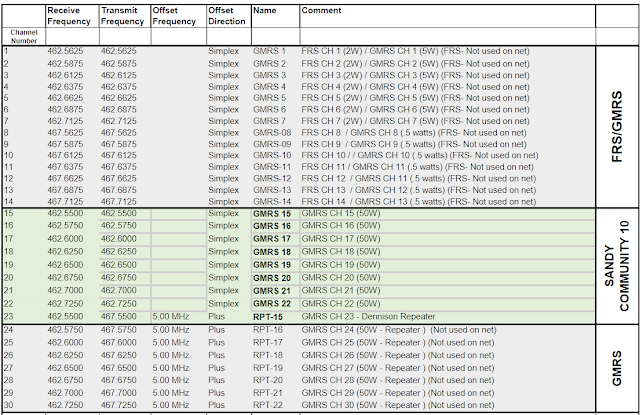What is GMRS?
GMRS
(General Mobile Radio Service) is a licensed radio service that uses UHF
channels for two-way communication. It’s stronger than FRS radios, allows
repeater use for extended range, and is ideal for families, neighborhoods, and
emergency groups. GMRS requires a license from the FCC, but no test is needed.
Why
GMRS Radio?
·
Emergency Communication: GMRS
radios provide reliable communication when phones and internet fail. Keep
your radio charged and ready!
·
Local Coverage: Repeaters
help you talk across valleys, cities, and mountains.
·
Community Connection: Nets
let you practice and meet other operators, ensuring everyone is ready to help
when needed.
·
Family Friendly: With
nets like the Kids Net, the whole family can learn and get involved.
Why
Get a GMRS License?
·
Covers Your Household: One
license works for your entire family.
·
Legal & Reliable: Ensures
you can use GMRS repeaters properly.
·
Strengthens the Community: More
licensed users mean stronger networks in emergencies.
Why
Your License Matters
Getting
licensed does more than make you legal:
·
Shows Demand:
The FCC sees that people value and use these frequencies.
·
Protects Spectrum:
More licenses mean GMRS channels are less likely to be sold to commercial
carriers.
·
Supports Public Safety:
Proves GMRS is an important public safety and community resource.
·
Keeps It Clear:
Licensing helps reduce interference so channels stay usable.
Your
license helps protect GMRS for everyone!
GMRS
Nets
Stay
connected with your community and practice using your GMRS radios each week!
Nets are a great way to meet other operators, learn how repeaters work, and be
ready to communicate in case of emergencies. https://onesteptoprep.blogspot.com/2022/05/how-to-participate-in-gmrs-radio.html
Weekly
Nets
· Sunday- Sandy Community 10, CH 22, 4:10 pm on 2nd & 4th Sunday
·
Sunday
– KIDS NET Mt. Ogden Repeater 6:30 pm, CH 17 – Mount Ogden 462.600 + DCS 114
·
Sunday-
Sandy/Ward GMRS Net CH 22 PL tone of 100 to access repeater, 7 pm
·
Sunday
– Mount Ogden Repeater 9:00 pm, CH 17 – Mount Ogden 462.600 + DCS 114
·
Tuesday
– Promontory Repeater 9:00 pm, CH 21 – Promontory 462.700 + DCS 114
·
Wednesday
– West-1 Repeater 8:00 pm, CH 15 – WEST-1 462.550 + PL146.2
·
Friday
– Local Simplex Net CH 20 8:00 pm
·
Friday
– National Simplex Net CH 19 9:00 or 9:30 pm
· Saturday – Capital Repeater 8:00 pm, CH 20 – State Capital 462.675 + PL 141.3
Connect with
local GMRS groups:
Facebook:
Radio recommendations:
· https://signalstuff.com/products/st-bnc/?band=440-monoband&color=black
·
https://signalstuff.com/products/adapt-smaf-bncf/
·
https://signalstuff.com/products/bncm-smam-adapt/
·
https://signalstuff.com/products/magmount-bnc/
·
https://www.buytwowayradios.com/wouxun-kg-805g.html?___SID=U
·
https://www.buytwowayradios.com/wouxun-wx-zipcase.html
·
https://www.buytwowayradios.com/wouxun-cco-001.html
How
to Get Your GMRS License:
Longer
version: https://www.youtube.com/watch?v=oVD7MotGAv8
Short
version: https://youtube.com/shorts/4lSEBryw4uw?feature=shared
Step 1: Register for a username/create new account with the FCC: (you will need this username & password in Step 2: https://apps2.fcc.gov/fccUserReg/pages/createAccount.htm
Check your email to verify that account, then:
Step 2: Register new FRN (Federal Registration Number) through CORES (Commission Registration System).
-
Click on Username Login (use your
FCC username & password created in Step 1.)
-
Choose Register a new FRN. Register
as an individual.
-
Fill out the FRN registration form.
Write down your FRN number & password and keep it in a safe place.
3.
Step 3: Apply
for a New License: Use your new FRN number to apply for a new license. (https://wireless2.fcc.gov/UlsEntry/licManager/login.jsp
-
Click “Apply for a New License” on
the left sidebar
-
Scroll ALL the way down to ZA –
General Mobile Radio Service.
·
Note that Form 605 is used for a number
of other applications, so be sure to go all the way down to ZA- General Mobile
Radio Service.
- Fill out the form.
Step 4: Pay
the $35 fee.
-
On the Manage Existing FRN Number
click on FRN Financial.
-
You should see your FRN number. Click on
the link to the right, complete the process to pay, and submit.
Step 5: Get your call sign.
Once
approved, you’ll receive your GMRS call sign by email. Start using it on the
air!
-
Your call sign should come within a few
business days. Check your junk mail if you don’t see it within 2-3 days.For more information,
contact Amy Dennison (amymorris2@gmail.com)
or tune in to the Sandy Community 10 GMRS
net, 2nd & 4th Sundays at 4:10 PM on Ch. 22.









